After you have purchased a license to use AfterMath Live, it’s time to use the software. This article discusses getting started with electrochemical simulation, where you can create your own electrochemical reaction and provide mechanistic details to generate your own cyclic voltammogram, for example. This guide only provides an initial walkthrough. From here, you can simulate to your heart’s content and really start understanding the fundamental thermodynamics and kinetics of electrochemical reactions and how we can interrogate them with techniques like cyclic voltammetry.
Launch AfterMath Live
Once you are signed in to aftermathlive.com, start an AfterMath Live session by clicking the Launch AfterMath Live button in the sidebar:

After your license is checked and is determined to be valid, a new browser tab will open to an AfterMath Live session:
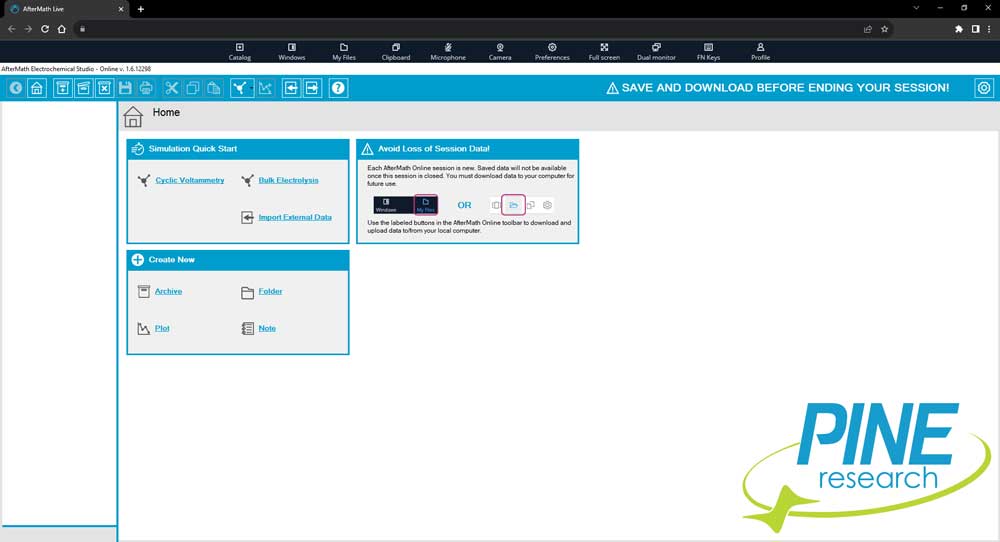
Create a New Cyclic Voltammetry Simulation
From the home screen, you can start a Cyclic Voltammetry simulation by either clicking the Cyclic Voltammetry link in the “Simulation Quick Start” window:

Or, from the Simulation icon in the blue toolbar, select Simulate Cyclic Voltammetry:
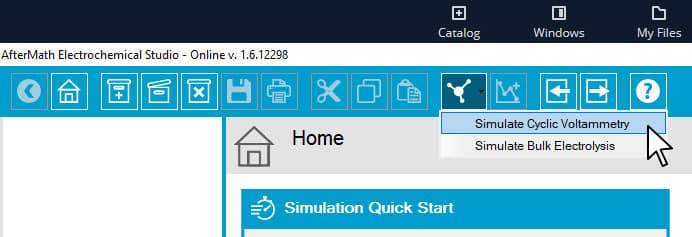
Doing so will open a dialog window where you can name the AfterMath Live archive file:
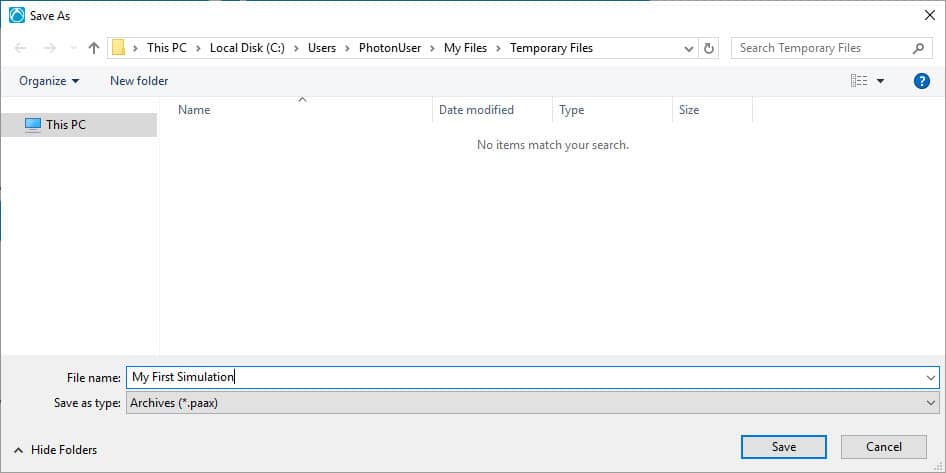
Here, you can provide your own file name (above, we have entered “My First Simulation”) and click Save. After saving the archive, you will notice the left section of AfterMath Live software shows an archive file named “My First Simulation.paax” with an EChem Simulation Parameters node contained within:

AfterMath Live uses a parent/child structure to organize file content. This single file is called an archive. An archive can contain as many different nodes as you would like. There are many nodes like parameters, studies, notes, plots, folders, and more. We suggest always organizing your simulation data as they are acquired, by adding and renaming folders as needed. You can rename any child node to suit your liking. Read more about AfterMath archives here.
Helpful Guidance
AfterMath Live electrochemical simulation includes a helpful “validation” indicator. This validation chip changes colors and text to help guide you through the process of defining a mechanism, defining an experiment, and providing settings to product an electrochemical simulation. Initially, the validation chip is in a “Validation” status as shown:

The Validation status indicates that you haven’t yet provided enough input for the software to know if there are potential cautions or errors. As you move along creating your mechanism and experiment, you may notice the state of of this chip changes. If you have provided values that are acceptable but on the fringe of realistic (as defined by our electrochemists), the chip will change to a “Caution” status:

Click the Caution chip and a dialog window will open to describe the concern. You will be able to perform electrochemical simulations even with the caution chip; however, do so knowing that your results may not be trustworthy based on the source of the caution chip.
If you provide incorrect values (or have violated our field validation, for example entering a letter instead of a number into a field), then the chip will change to an “Error” status:

Click the Error chip and a dialog window will open to describe the error. You will have to correct the error before you can perform a simulation.
If all values that are required have been provided and all values are within the allowed limits for their fields, the chip changes to a “Valid” status and you can proceed with your simulation:

Define your Electrochemical Reaction
When “EChem Simulation Parameters” node is selected in your archive list, you will see the right side of the program displays a series of content sections and accordion toggles:

For our purposes here, we will move through each important section quickly and use the “AutoFill” feature to provide reasonable starting values. We will work through each section: Mechanism, Experiment, and Settings.
Mechanism
The first accordion toggle is Mechanism. This is where you will create your electrochemical mechanism, which is a combination of electrochemical (charge transfer) and/or chemical reactions, their kinetic and thermodynamic values, and definition of the species involved (and their diffusion coefficient and concentrations).
Some versions of AfterMath Live allow users to quickly create a “standard” reaction mechanism, like ECE, from the Mechanism dropdown menu. These Pre-Defined Templates make it faster to create a mechanism. The Student version does not include access to the Pre-Defined Templates. For this demonstration, we will select “User-Defined” from the mechanism dropdown (the steps below are the same if you are using a Pre-Defined Template):
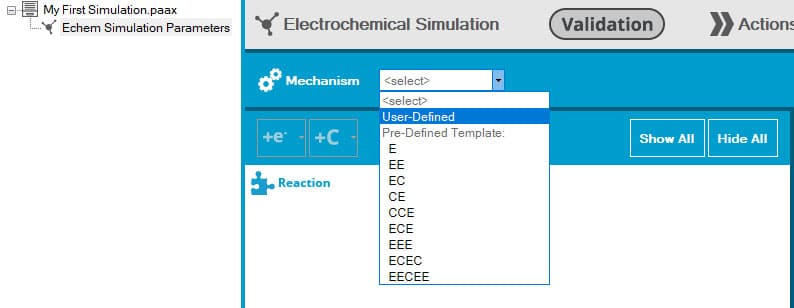
After Selecting User-Defined, now you can create your own reaction. Use the +e– and +C buttons to add electrochemical (charge transfer) and/or chemical reactions, respectively. Note: the number of reactions you can add to a mechanism are limited by the license you have. More advanced licenses (e.g., Basic and Research) provide users with the ability to add many reactions, whereas the Student license is limited to four reactions. Here, click the +e– button. We will proceed with a simple E reaction in this walkthrough. After clicking the +e– button, notice that a large white E appears next to the Mechanism dropdown, indicating that at present, your reaction is an E reaction. Also notice that within the Reaction pane, you now see a set of fields associated with this reaction:

Electrochemists generally use E and C to designate whether a reaction step in the mechanism is Electrochemical or Chemical reaction. With this convention, an ECE reaction is electrochemical > chemical > electrochemical reaction. Keep in mind, these reactions occur at the same time, even though we model them as sequential reactions.
Next, you must define your reaction details. First, start with assigning your reactant and product species with a label. You can use any single letter except the following: E, H, and L (E is so commonly used in electrochemistry we have chosen not to allow its use as a species label, H is reserved for hydrogen ions, and L is reserved for “ligand” which will be used in advanced versions of AfterMath Live). Here, let’s use A and B. Notice that after assigning each species with a label, entries to define the species details appear to the right of the reaction:
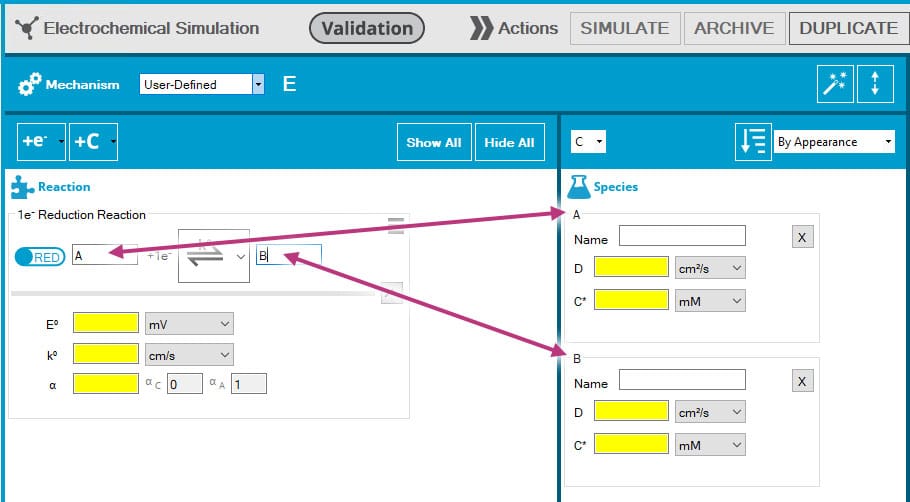
At this point, you have defined an E reaction in your mechanism, which is
$A + e \rightleftharpoons B$
For the purposes of getting you started with your first cyclic voltammetry simulation, we will dispense with detailed descriptions of the fields and their symbols, terms, and values. These are typically covered in courses or various electrochemical texts. We have another article to describe the fields in more detail, if you would like to consult there.
Next, you can either manually enter values for all fields shaded yellow, or click the AutoFill button, which will fill in all fields with some reasonable starting values. Here, let’s click the AutoFill button:

Now, all required fields have been provided with reasonable starting values. You can supply an optional name for the species in the Species section of the Mechanism accordion toggle, but they are not required. For example, if you were performing a simple cyclic voltammetry simulation of ferricyanide, whose reaction is:
$Fe(CN)_6^{3-} + e \rightleftharpoons Fe(CN)_6^{4-}$
you may choose to enter $Fe(CN)_6^{3-}$ in the Name field for species A and $Fe(CN)_6^{4-}$ in the Name field for species B. These fields are entirely optional.
You have now completed the necessary work for the Mechanism, move on to the Experiment accordion toggle by clicking the toggle button.
Experiment
Within the Experiment accordion toggle you will be able to select an experiment (here, Cyclic Voltammetry is already selected from the dropdown menu) and enter the experimental parameters that you wish to apply to the mechanism you just defined in the previous step.
At this point, provide values for all fields shaded yellow, or click the AutoFill button (as before in the Mechanism step) to quickly provide reasonable starting values:
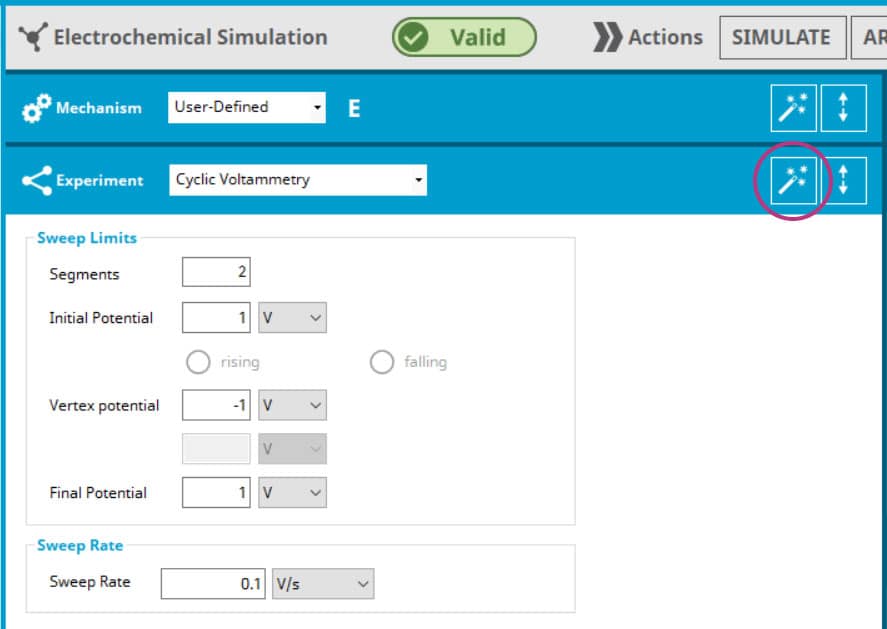
Notice that after entering the Experiment values (or clicking the AutoFill button), the status chip changes to Valid. This indicates that all the required information has been provided to run the cyclic voltammetry electrochemical simulation. For good measure, we will inspect the Settings tab next before we run the simulation.
Settings
Click the Accordion toggle arrow to open Settings. Here are extraneous (but important) experiment settings that you can change. NOTE: Not all fields may be included with your license. For example, Double-Layer Capacitance is only available in the Research license whereas Uncompensated Resistance is only available in the Basic and Research licenses. Each of these fields are described in another document; however here you may wish to change common settings like Electrode Area and Temperature:
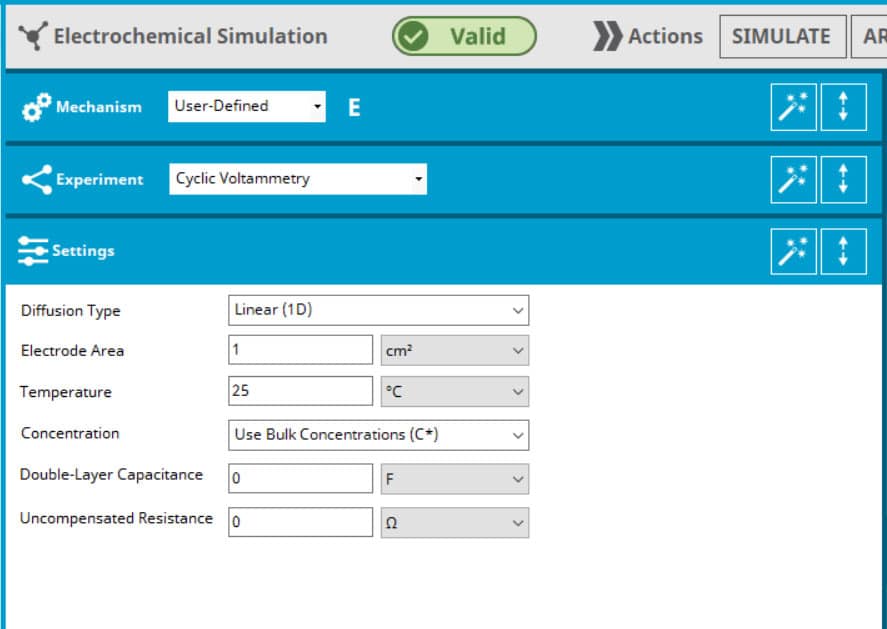
You have now visited each critical section: Mechanism, Experiment, and Settings. From here, it is time to simulate!
Perform Simulation
From the main Electrochemical Simulation (gray) toolbar, notice three Actions buttons: SIMULATE, ARCHIVE, and DUPLICATE:

Clicking SIMULATE will run the simulation, as you have entered it. The resultant plots will be shown to the right side of the application:

When you click SIMULATE, the data are not written to the archive. The idea is that you can tweak your simulation variables as desired and instantly visualize the response without filling up your archive with unnecessary clutter.
By default, the top plot will be the cyclic voltammogram (a plot of simulated current vs. simulated applied potential). The bottom plot will be the surface concentration (a plot of concentration vs. time for each species in your mechanism).
Both plots have a dropdown menu that allows you to change the view to a different plot, such as surface concentration, which is a plot of concentration vs. distance for each species:
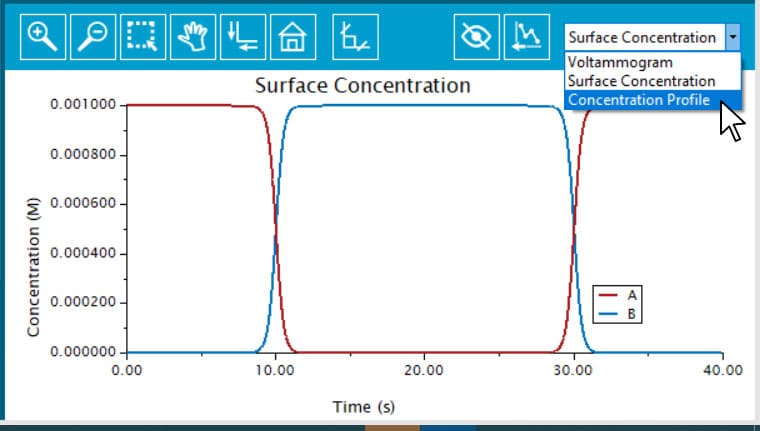
You can also animate the simulation by clicking the buttons on the animation toolbar, as shown in this video:
Clicking ARCHIVE will run the simulation, as you have entered it (just like when you click SIMULATE), and also add the simulation to the Archive:

You may want to rename this node (right click > Rename) so you know what it contains. Clicking the + on the “CV Simulation Results” node provides you with a lot of simulation detail:
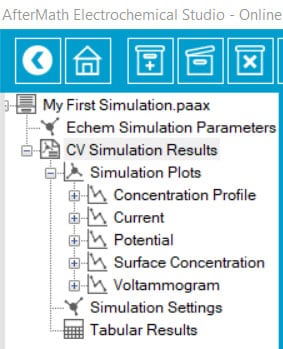
Each time you ARCHIVE a simulation, you will get an entry in the AfterMath Live archive. Within the “CV Simulation Results” [Simulation Study Node], you will find:
- Simulation Plots
- Concentration Profile (concentration vs. distance of each species)
- Current (simulated current vs. time for the mechanism)
- Potential (simulated applied potential vs time for the mechanism)
- Surface Concentration (concentration vs. time of each species)
- Voltammogram (simulated current vs. simulated potential for the mechanism)
- Simulation Settings – this is a read only copy of all of settings: mechanism, experiment, and settings.
- Tabular Results – this node provides you a dropdown list of all data traces available, as data tables for easy copy/paste
For each plot, the plot toolbar is now active. This toolbar enables you to select points, zoom in/out, pan the view, adjust axes, quick export, and more. Most things you can do with AfterMath you can do with AfterMath Live. Details of how to use plot tools are found on the Pine Research Knowledgebase.
Save and Download Data
That’s it! Congratulations! If you were following along, you have now generated an cyclic voltammetry electrochemical simulation on AfterMath Live! We think you are more than “getting started” now! Just think of the endless possibilities of what this tool and resource can mean for your learning, research, and teaching!
Do not forget, if you want to be able to view these data again and/or add more simulations to the archive, you must Save and Download. Saving is easy – just click the save icon in the toolbar:

Doing so saves the current archive to the temporary save folder in AfterMath Live. Saving the archive alone will not allow you to view it later. You must download the archive to your computer, such that in another session, you can upload the archive and continue to add to it, view it, and edit it.
To download the archive, click the My Files button/icon in the AfterMath Live Portal Toolbar (see this article for details on the Portal toolbar):

Doing so will open the My Files dialog, where you should then click “Temporary Files”:

Next, you will see a list of all files you have saved from AfterMath Live (or uploaded to AfterMath Live). Check the box next to the file you want to download and then from the Actions dropdown menu, click “Download:”
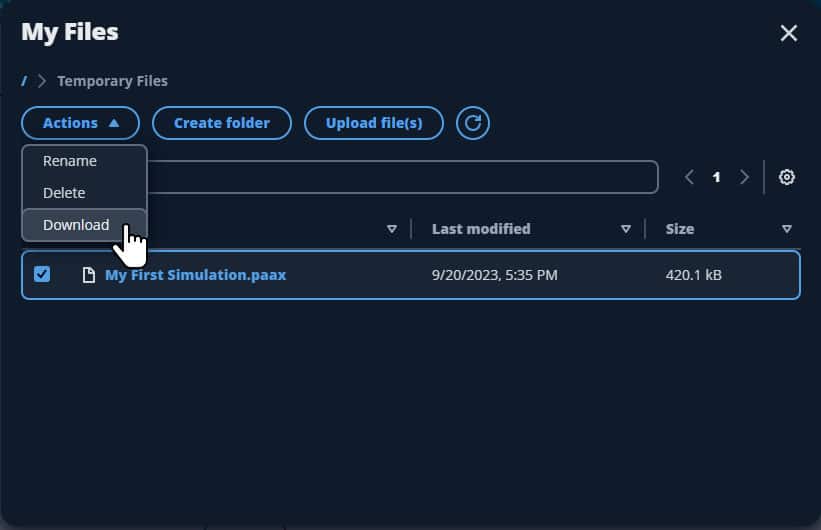
This will download the archive to your local computer. Next time you want to view/edit/add to this archive, you can upload it from your local computer to AfterMath Live.
This completes the Getting Started with AfterMath Live Electrochemical Simulation tutorial. There are additional documents that may be helpful as you discover how helpful electrochemical simulation can be for your learning, teaching, and research. You can also always contact us with any questions and our team of electrochemical scientists will be happy to help!